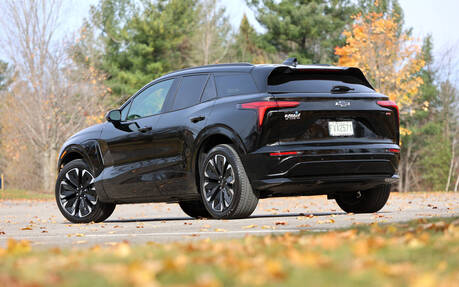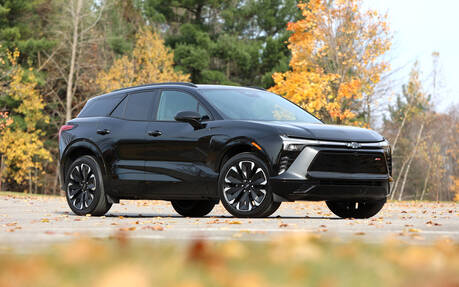2024 Chevrolet Blazer EV: Don't Call it a Camaro IROC-E
Ford was one of the first automakers to sell a fully electric midsize crossover, the controversially named yet popular Mustang Mach-E. Chevrolet struck back last year with the introduction of the Blazer EV, which has no connections whatsoever with the gas-powered Blazer other than the name.
This model is gunning for the Mustang Mach-E and the Tesla Model Y. In fact, the top-line Blazer EV SS arriving next year with 557 horsepower will go head to head with the Mustang Mach-E GT Performance and Model Y Performance. None of them are eligible to any EV rebates, but they pack quite a punch and can pin you to your seat every time you hit the throttle.
- Also: Chevrolet Adjusts 2024 Blazer EV Pricing, Timing as Units Leave the Plant
- Also: 2024 Chevrolet Blazer EV: Five Things to Know
The regular Blazer EV? Not so much. There are three trim levels to choose from including 2LT AWD, 1RS AWD and 2RS RWD, the latter offering up to 515 km of range versus 449 km when selecting one of the other two. All of them feature an 85kWh battery and deliver 288 horsepower—modest output given the curb weight of 2,420 kg. Consequently, acceleration isn’t as strong as you’d expect.

To be clear, the Blazer EV doesn’t lack power. It’s just that we’ve seen more explosive EVs than this one. Also, Chevy’s focus with the non-SS models is to maximize range, which is smart.
Supremely Comfortable
While the heavy weight of the Mustang Mach-E results in a stiff and sometimes unpleasant ride, the Blazer EV feels lighter and much more comfortable, in part thanks to a long wheelbase (3,094 mm). Ride quality is by far superior to both of the aforementioned rivals.
Chevrolet engineers have succeeded in making their electric crossover as smooth and quiet as a full-size luxury sedan. On top of that, despite the long wheelbase and lack of four-wheel steering, the Blazer EV can turn on a dime, as evidenced by its extremely short turning radius. That’s huge for drivers who spend a lot of time around town or have to deal with tight parking lots.

The Blazer EV naturally uses GM’s new Ultium modular platform, just like the Cadillac Lyriq. The automaker is banking heavily on this promising but still unproven architecture, as you probably know. It even agreed to share it with Honda, whose equally new Prologue boasts the exact same wheelbase as the Blazer EV.
Life Inside the Blazer EV
Our tester for this review—a full month before the official media launch—was a demo from Paillé Chevrolet in Berthierville, Quebec. The first customer units will be delivered early in 2024. The 1RS is $10,000 more expensive than the base 2LT and better equipped, too. While options and packages have yet to be announced, we imagine there’s a way to jazz up the 2LT and elevate luxury to match the 1RS.
It probably won’t look as sporty, though. The Blazer EV 1RS stands out with 21-inch wheels, a gloss black grille and lower body, illuminated bowtie emblem, roof rails and more. Inside, there’s unique cloth upholstery and contrast stitching for a more dynamic appearance.

The front seats may lack a bit of support, but it’s hard to complain about comfort. The driving position is excellent, and visibility all around impresses just as much, the digital rear-view mirror making up for the tight rear window. What about the driver-oriented, 17.7-inch touchscreen? We’d be inclined to give it a perfect score based on the superb, high-quality graphics. On the other hand, GM has chosen to get rid of Apple CarPlay and Android Auto in all next-generation EVs, so that could be a source of frustration for some drivers.
The good news is that the infotainment system is Android-based, meaning you have easy access to the best navigation app there is—Google Maps. Incidentally, there are tabs on the screen for manually activating the headlights or even turning the vehicle off. That’s because there’s no physical start-stop button, as is the case in the Bolt EV. All you need to do is to depress the brake pedal to get the Blazer EV started.
The very accommodating interior offers generous space for five, while the modular cargo area can fit as much as 1,646 litres of gear with the rear seats folded. Unlike the Mustang Mach-E or Model Y, however, the Blazer EV lacks a frunk under the hood. Even a tiny storage bin would have been nice to keep valuables away from prying eyes.

Real-World Range
We put the Chevrolet Blazer EV to the test over three days with temperatures hovering around the freezing point. It managed to achieve up to 381 km with a full charge in a mix of city and highway driving. Remember, the 1RS AWD model offers a GM-estimated 449 km of range. Similar to Korean competitors, regenerative braking can be adjusted in order to maximize range. We think it’s safe to expect the vehicle to cover around 300 km in winter conditions.
It’s worth pointing out that both the base 2LT AWD (MSRP starting at $59,999) and the 1RS AWD ($69,999) qualify for the Canadian government’s $5,000 EV rebate. Some provincial incentives also apply. The two models have the same powertrain and battery, yet the cheaper one is likely to enable longer range at it rides on much smaller wheels (18 inches vs. 21 inches). As for the 2RS RWD, pricing is on par with the 1RS AWD at $69,999, but that model can take you farther.

At the end of the day, the 2024 Chevrolet Blazer EV is mightily convincing and should enjoy plenty of success even with the more affordable Equinox EV and next-generation Bolt EV coming down the line. Reliability concerns remain, of course—we’re talking about a vehicle that was designed from scratch. The motorized charge port door may look cool, but it probably won’t last the first winter.
| Test drive report | |
| Test model | 2024 Chevrolet Blazer EV |
|---|---|
| Trim level | 1RS |
| Price range | $59,999 – $69,999 |
| Price as tested | CA$69,999 |
| Warranty (basic) | 3 years/60,000 km |
| Warranty (powertrain) | 5 years/100,000 km |
| Fuel economy (city/highway/observed) | N/A |
| Options | N/A |
| Competitive models | Audi Q4 e-tron, Ford Mustang Mach-E, Genesis GV60, Genesis GV70, Hyundai IONIQ 5, Kia EV6, Lexus RZ, Mercedes-Benz EQB, Nissan Ariya, Tesla Model Y, VinFast VF 8, Volkswagen ID.4, Volvo C40 Recharge, 2024 Honda Prologue |
| Strong points |
|
| Weak points |
|
| Editor's rating | |
| Fuel economy | Our tester achieved around 20 kWh/100 km in combined city and highway driving, which is pretty decent. |
| Comfort | The long wheelbase (3,094 mm) contributes to exceptional ride quality. |
| Performance | The Blazer EV doesn’t lack power, but we’ve seen more explosive EVs. |
| Infotainment | While Apple CarPlay is missing, the Android-based system works great. |
| Driving | Comfort and handling make for a pleasant driving experience. |
| Overall | A remarkable product despite a few quirks. Reliability is a question mark. |
